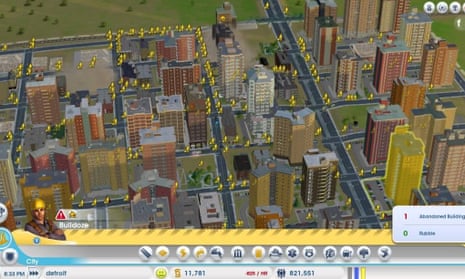An Italian artist has written a 600-page, US$220, two-volume book on homelessness in the video game Sim City.
Matteo Bittani’s “How to get rid of homeless” collects dozens of forum threads debating and discussing the homelessness that occurs in the game, highlighting the uneasy similarities between the players’ discussion of virtual homelessness and real-world conversation about the same topic.
The selections begin in 2012, before the game was even released, with a request to add “the homeless” into the game. An EA Games forums user IanLoganson wrote: “Most cities have homeless, though in the west it isn’t that [much] of an issue. Some of the world’s biggest cities now are in rapidly developing countries and one big problem them seem to have is slums.”
But once the game was released – with its depiction of homelessness included – the questions become more sinister, especially when taken out of the context of the EA Games forums. “How do you get rid of these people,” asked 1ButtonDash, a year later. “They gather in parks and then people don’t go to parks.”
“I mean as you level-up your residential to medium I think it’s almost impossible for some people to not become homeless. I read that buses are supposed to take them out of the city but it doesn’t seem to be working … If anyone has gotten rid of em plz let me know what you did.”
One player asks: “How do homeless people come to be? Does anyone know? I’m pretty sure it has to do with residential running out of money and becoming abandoned, but I haven’t been able to confirm this.” A second replies “a better question would be, how do you kill homeless Sims?”
And in a post titled “the upside to disasters” another points out that every storm has a silver lining: “Tornadoes kill homeless sims. I don’t know how to get rid of them otherwise.”
Speaking to Vice, Bittanti said the project began because “I started to find the discussion about homeless in SimCity way more interesting than SimCity itself because people were talking about the issue in a very – how can I say, not racist, not classist, but definitely peculiar way.”
“Decontextualised from their original source and reproduced on paper sans the majority of online communication hallmarks (eg author’s signatures, side banners, avatar pictures etc), these textual exchanges create a peculiar narrative,” Bittanti writes. Some comments “reveal racist and classist biases, and forcefully introduce – or, rather, reintroduce – a highly political vision that the alleged “neutral” algorithms were supposed to overcome.”
“To me video games are the so-called real America,” he told Vice. “The real America operates according to a video game logic, and that game logic is neo-liberalism, and that absolutely manifests in San Francisco, that to me is the epicenter of inequality. In San Francisco you either have a Tesla and you drink a seven dollar cappuccino or you’re homeless in the streets.”
A previous book by Bittanti tackles a similar topic. A New American Dream collects images of homeless people taken from Google Street View in San Francisco. “Over a period of two years, Coll.eo took advantage of the Google’s mass surveillance tool to virtually - and, above all, safely - drive the unseen and overlooked roads of San Francisco, bleak places that are forgotten, economically devastated, and completely ignored by the digerati,” he writes.
Older editions of Sim City have also provoked artists and fans to ask uncomfortable questions about the nature of society. In 2010, Vincent Ocasla created a megalopolis in SimCity 3000 which he called Magnasanti. Designed intricately on graphing paper over four years before ever being brought to life in the digital realm, the city holds the maximum possible population for the game. It’s a wonder of urban design, and a totalitarian nightmare, full of enormous tower blocks linked by subways. Ocasla’s game runs for 50,000 years, holding a population of 6 million people with zero abandoned buildings, zero water pollution, and zero congestion.

Comments (…)
Sign in or create your Guardian account to join the discussion